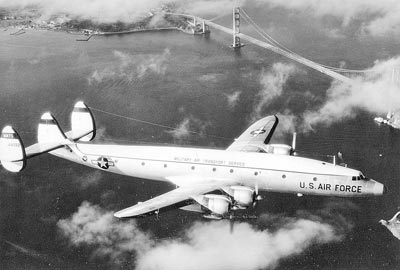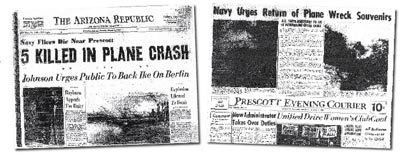 |
 |
|
October 08, 2011 |
|
2/6/2011
9:56:00 PM
Plane
crash in Prescott a half-century ago still a
mystery
|
|
 |
| A
Military Air Transport Service C-121G, similar
to the craft shown above crashed just off
Highway 89, some 5 1/2 miles north of Prescott.
Metal fragments from the plane remain at the
site more than five decades
later. |
 |
 | | 
PRESCOTT
- Even by Prescott's high standards, it was an
unusually fine winter afternoon - temperatures
in the 60s, clear skies, and virtually no
wind.
The perfect
conditions only heighten the mystery: Why did an
airplane carrying five U.S. servicemen plummet,
nose-first, into Prescott's Granite Dells on a
Saturday in February 1959?
The crash, which
killed all five U.S. Navy airmen on board, made
news all over the state and even around the
country.
It was the lead
story in The Arizona Republic's Sunday edition
the next day, as well as in the Yuma Daily Sun.
The Prescott Evening Courier continued
front-page coverage on the following
Monday.
Occurring as it
did, just miles from Prescott's city center and
on a state highway, the crash was undoubtedly
the talk of the town for weeks, and residents
reportedly flocked to the site. At one point
afterward, the Navy put out a call to local
residents asking for the return of "souvenirs"
that may have been collected from the crash
scene.
Still, the
community appears to have received few answers
about what went wrong with the training mission
that originated at the Litchfield Naval Air
Facility near Phoenix and was heading toward the
Prescott
Airport.
Decades later -
in 1996 - a retired U.S. Marine Corps Colonel
submitted a Freedom of Information Act request
to the U.S. Air Force to find out more about
what occurred in the Feb. 28, 1959, crash. But
even the results of that request appear
inconclusive, with significant segments
"redacted" or blacked out of the report.
Now, more than a
half-century later, it is unusual to find anyone
in the community who has even heard of the
crash.
That is changing,
however, as the City of
Prescott's Parks and Recreation Department
works on a network of new recreational trails
among the granite outcroppings that line Highway
89, just across the road from the Phippen
Museum.
The land
where the crash occurred is the same property
that the city acquired in 2008 in an 80-acre
open-space purchase from the Harold James Family
Trust.
Even all these
years later, small fragments of twisted metal
remain in the dirt just off the highway - a
reminder to the city employees and trail
volunteers that the spot carries a somber
history.
And that has
some local officials pushing for a public
memorial at the crash site.
As city Trails
Specialist Chris Hosking worked alongside
volunteers recently to build the new trails, he
suggested that veterans' groups or other
organizations might work on a memorial "as a way
of honoring the five guys who died
here."
What went
wrong?
A number of
factors make evaluation of the crash difficult.
For one thing, it happened 52 years ago - at a
time before airplanes carried the recording
technology that is common today, said Robert
Fiegl, department chair of aeronautical science
at Embry-Riddle Aeronautical University.
"They didn't
have flight recorders back then," Fiegl said,
noting that the final conversations among the
crewmembers were lost. In addition, Fiegl
added," There wouldn't have been a control tower
(at the Prescott Airport)."
Another major
factor in the investigation: The crash involved
a military aircraft. Fiegl, who retired from the
Navy several years ago after 38 years, said the
military's involvement put the crash
investigation under strict confidentiality
rules. That is apparent in the Freedom of
Information Act response letter that Carlsbad,
Calif., resident Merritt Chafey received in 1996
from the Headquarters Air Force Safety Agency
concerning the 1959 crash.
The letter, which
is on file at Prescott's Sharlot
Hall Museum, stated: "The statements of
witnesses giving unsworn testimony before the
safety investigating board ... are exempt from
disclosure under the United States
Code."
The letter added
that witnesses were given a "promise of
confidentially" in order to encourage them to be
completely truthful. Even decades later, the Air
Force must adhere to that promise, the letter
said, because doing otherwise "would jeopardize
a significant government interest by inhibiting
its ability to conduct future safety
investigations of Air Force aircraft
mishaps."
That resulted
in major portions of the witnesses' accounts
being blacked out of the report that Chafey
received.
Even though
Fiegl pointed out that the investigation report
had been "sanitized," he was able to make a
number of observations from the available
information.
For
instance, he noted that while the airplane - a
Military Air Transport Service C-121G - was
registered to the U.S. Air Force, the entire
crew was made up of Navy airmen. "That doesn't
happen now," Fiegl said. "It is very structured,
with an eye toward safety."
The C-121G,
developed from the Lockheed Constellation, was a
large four-engine airplane, Fiegl said, which
was used extensively by the airlines and the
military.
While the
investigation report concludes that "all
instruments and electrical components recovered
were in operating condition at the time of
impact," it gives no possible reasons for the
crash.
Even so, Fiegl
said an experienced pilot could speculate about
what might have occurred.
"Anybody who's
flown airplanes professionally or in the
military knows how many things can go wrong -
those one-in-a-million or one-in-10-million
things," he said.
What
is apparent to Fiegl from the report is that the
large airplane was flying low over the Dells,
perhaps preparing to land at the Prescott
Airport to the north. For some reason, the plane
stalled and lost the "lift" required to sustain
the flight.
"They may
have been the victims of just getting too slow,"
Fiegl said.
That could
have happened for any number of reasons, he said
- a large bird flying into the windshield, for
instance, or another plane appearing in the
flight
pattern.
"Witnesses
heard a roar of power," Fiegl said, inferring
from that that the crew "realized they were
getting in trouble," and tried to make a
correction. But, he said, "You're not coming out
- not with that little altitude to the
ground."
At that point,
the plane rolled sharply to the right, began
spinning, and careened into a "near-vertical,
straight-down dive," Fiegl said.
'Like an atom
bomb'
Newspaper
accounts from the time note that a number of
passers-by witnessed the plane crash, and even
came close to becoming victims of it.
William Watson, a
44-year-old California man and his 14-year-old
nephew Robert Schilling were driving on Highway
89 at the time, and saw the plane nose-dive
directly in front of them on the
highway.
Watson reports
that his windshield suddenly "seemed to fill up
with the airplane," which was "heading almost
straight down."
Local
rancher Sam Steiger, who would later serve as a
U.S. Congressman and Prescott Mayor, reported
standing in a field across from the crash and
seeing the plane "coming down in a vertical
dive."
Others described
the explosion that occurred when the plane hit
the ground as "like an atom bomb," with the fuel
on board catching fire immediately.
The flaming
wreckage reportedly was spread over a half-mile
area, setting fire to the trees and underbrush
in the Granite
Dells.
According to the
account in The Arizona Republic - on file at the
Arizona History and Archives Division of the
Arizona State Library - "Persons miles away from
the crash scene said they saw a huge flame
billow into the sky and heard a tremendous
explosion. Others were attracted to the scene by
huge clouds of black smoke."
Long-time
resident and local historian Elisabeth Ruffner,
91, was among those who felt the impact. "I was
standing in my kitchen, and I heard the crash,"
she said recently, explaining that she and her
family then lived near the Antelope Hills Golf
Course, not far from the Highway 89 crash
site.
With World War II
"still very much a presence in our lives" at the
time, Ruffner said the crash of a military plane
was major news in the community.
The impact
from the plane gouged out a portion of the
asphalt on Highway 89, and long-time residents
remember that a patch remained in place on the
road for years afterward.
Blending
history,
recreation
Soon
after the city bought the 80 acres of open space
about three years ago, talk began circulating
about constructing a memorial to the crash's
five victims.
Along with
Hosking, a number of others have been involved,
including then-Historic Preservation Specialist
Nancy Burgess, parks and recreation employee Jim
Boyd, and City Councilwomen Lora Lopas and Tammy
Linn.
Boyd envisions a
memorial consisting of a bench and a wall,
listing the names of the victims: Lt. Theodore
Rivenburg, Commander Lukas Dachs, Lt. Edward
Francis Souza, Engineer James Miller, and Flight
Engineer Calvin Coons, all from
California.
Boyd said he
earlier talked with veterans and Boy Scouts who
might be interested in taking on such a
project.
Meanwhile,
Hosking and the Over the Hill Gang - a group of
mostly retired volunteers dedicated to
constructing trails in the area - are working to
build a network of about 3 miles of trails that
would traverse the shelf of granite that fronts
the highway. Eventually, the new trails could
connect with a similar system near Willow Lake,
although Hosking said he is still working on
right-of-way for
that.
Linn, who
volunteers with the Over the Hill Gang to build
the trails, noted that fragments of the plane
crash are visible throughout the area. "The
fragments are so small and so spread out," she
said recently as she another other volunteers
worked on the
trails.
Linn foresees
the trails and a future memorial blending
together for a unique hiking experience. "Not
only is it beautiful, but there aren't many
trails honoring history like this," she
said.
A memorial at the
site is also something that Fiegl, as a retired
Navy Captain, would like to see. He noted that
such a project would bring attention to a crash
that most local residents appear to know little
about.
Hosking said he
plans to name the new system the "Constellation
Trail," after the name of the downed
aircraft.
| Cindy Barks Prescott Daily
Courier  Copyright Prescott Daily
Courier 2011 All rights reserved. This material
may not be published, broadcast, rewritten or
redistributed. February 6, 2011
11:07 Copyright Prescott Daily
Courier 2011 All rights reserved. This material
may not be published, broadcast, rewritten or
redistributed. February 6, 2011
11:07
| |
 |
 |
 |
 |
|
| |